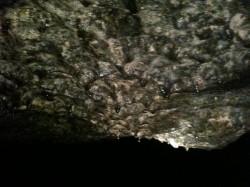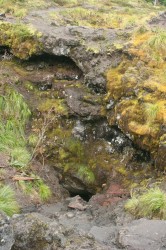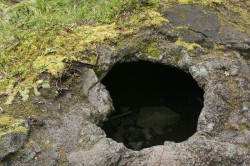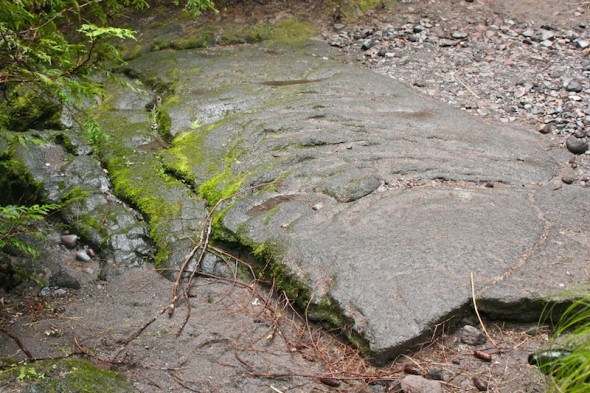For my wife’s birthday I took the day off work, arranged child care and gave her a choice between two adventures (both about 2 hours away). Her first option was a hike to Ramona Falls in the Mount Hood National Forest, a 7-mile forest stroll with an impressive waterfall. Her second option was a visit to the Ape Cave in the Gifford Pinchot National Forest near Mount St. Helens. She had been to Ramona Falls many years ago and the Ape Cave seemed more adventurous so her choice was simple.
Formation
The Ape Cave is a lava tube, a type of cave commonly found throughout the Pacific Northwest. Lava tubes result from flows of low-viscosity basaltic lava, called “pahoehoe” flows, which are drastically different than the explosive pyroclastic flow resulting from the Plinian eruption of Mt. Saint Helens in 1980. As the lava is expelled from the volcano, its surface hardens and forms a crust enclosing a conduit of smooth flowing lava. Eventually the conduit drains leaving a hollow tube and step marks on the walls, called flow ledges, denoting the depth of the flow. After the tube forms and drains, the ceiling of the tube may fracture and create rock-piles that cover the floor. This, along with natural erosion, eventually creates sinkholes and skylights allowing access to the tube.
When most people think of caves, they envision limestone caverns created by water slowly acting on soluble limestone over thousands of years. Features such as flowstone, stalactites and columns are common to such caves and they are very non-linear with many unique rooms and chambers connected with crawlspaces. Many have active rivers running through them and hold underground lakes. Lava tubes are completely different. Their formation does not involve water and happens relatively quickly. They tend to be very linear, sloping down (with the lava flow) and retain a mostly uniform tube shape. Their features may include stalactites (called lavacicles), lava columns and even lava balls. The Ape Cave is one of the few known tubes to contain a lava ball, a large circular piece of hardened lava wedged between two flow ledges. Where limestone caves have waterfalls, lava tubes have lava falls that have since hardened, creating an abrupt drop-off to a lower section of the tube. Because they exist near the surface, lava tubes are damp and feature dripping water that moistens the cave walls nourishing a type of fungal and bacterial life called “cave slime”.
The Ape Cave was formed approximately 2000 years ago in the aftermath of a pahoehoe flow from a relatively benign eruption. In a geological time frame this is equivalent to “yesterday”. The volcano is active, with frequent eruptions over the last 2000 years. In fact, I remember flying over Mount St. Helens during its most recent eruptive phase in 2006 as it was expelling a cloud of steam that probably reached an altitude of one thousand feet above the vent.
History
The Ape Cave itself was discovered in the late 40s and possibly the early 50s. Stories of how it was found vary on the Internet but the general consensus is that a logger discovered the cave when his truck fell into a sinkhole. The cave was later explored by a Boy Scout troop who named it after their sponsor, a group of foresters known as the Mt. St. Helens Apes. Since its discovery the cave has been a tourist attraction and offers a gentle hike in the lower cave and an adventurous spelunking tour in the upper cave. The cave is known for being one of the longest intact tubes in existence.
Our Trip
Prior to departing, we did a bit of reading about the cave and prepared with three flashlights, warm clothes, food and good shoes. The forest road to the cave was well marked and paved. After our arrival we visited the lower cave entrance, a short walk from the parking lot. At the info board there, we learned there are two entrances and two sections of the cave presenting two different levels of difficulty:
- The upper cave, about 1.2 miles in length, is the more adventurous segment and features a skylight, a natural opening in the ceiling formed by erosion. This segment also features obstacles such as more than 20 large rock piles, drop-offs, sharp uneroded rock and several lava falls, including an 8-foot fall. The entrance to the upper cave is also about 1.4 miles away following the Ape Cave Trail with approximately a 500-foot elevation gain.
- The lower cave by contrast is a gentle 3/4 mile stroll with a smooth floor and walls, the result of more erosion. It features a lava ball, a relatively rare speleothem formed by hardened breakdown rolling in the lava flow, accumulating mass resulting in a roughly spherical shape.
We were craving adventure and didn’t have a kid to watch so naturally we chose the upper cave. As we were new the area we didn’t realize that most visitors just walk the lower passage and call it a day. We also didn’t realize that those who do attempt the upper cave do so by entering at the lower cave entrance and simply walk the upper passage instead. This allows them to scale the lava falls rather than attempting to climb down them. In fact, once we returned home we read many comments about cavers who had to turn back because they feared trying to climb down the 8-foot lava fall. Fortunately, we didn’t have a problem with the lava fall and found that a downhill walk inside the cave made it more enjoyable.
Our time in the cave was incredibly fun and we would highly recommend it, but do plan for an entire day. We arrived late in the day and spent three hours on the Ape Cave Trail and the upper passage combined. We didn’t have an opportunity to fully explore the lower cave so we will be going back.
Tips for Exploring the Ape Cave’s Upper Passage
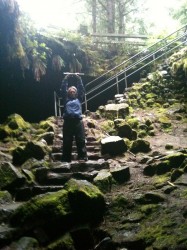 Light: you need it! The cave is pitch black, as in your eyes will never adjust to the darkness. Take a strong flashlight (I used a 5-cell Maglite) and take a back-up. You don’t want to get stuck in the upper cave without light.
Light: you need it! The cave is pitch black, as in your eyes will never adjust to the darkness. Take a strong flashlight (I used a 5-cell Maglite) and take a back-up. You don’t want to get stuck in the upper cave without light.- Clothing: we were overdressed and that added an unnecessary burden. You should wear long pants and at least two layers (a shirt and a winter coat worked for me). My wife found having rain pants over her jeans helped keep her warm and dry (the cave is very damp). Also, a hat is great to keep your head warm and dry from the constant dripping. The cave maintains a temperature of 42 deg Fahrenheit year round and can get breezy, so warm clothes are a very good idea, but don’t overdo it.
- Shoes: good shoes are a must. I wore a pair of Danner hunting boots, waterproof with thick soles and good tread. The jagged rocks tore my boots up, but they kept me on my feet and kept my feet dry. My wife forgot her hiking boots and wore a pair of Danskos instead. She managed but she did twist her ankle a few times and she was very uncomfortable after stepping in a puddle on the cave floor. A shoe with good ankle support is a must.
- Food: we had some beef jerky with us and that kept us going for the 2.5 hours we spent underground. Also bring some water!
- First Aid: We had some bandages with us and did end up using them. To be fully prepared, you should carry an ankle brace and possibly splint. There are many opportunities to severely sprain an ankle or break a bone, so be prepared for these possibilities.
- Camera: we brought a “disposable” 8 year old digital rebel SLR camera and a tripod. The lens quickly fogged up due to the dampness of the cave so we ended up using our iPhones which took better pictures anyway. Don’t bother with photography equipment in the upper cave, it will slow you down and probably get damaged.
- We didn’t have but still recommend a hardhat and a pair of fingerless gloves. The ceiling is low in a few spots and we both walked into it in a few times. While we didn’t fall, a pair of gloves would protect your hands since the floor of the upper cave is less eroded and sharp.

